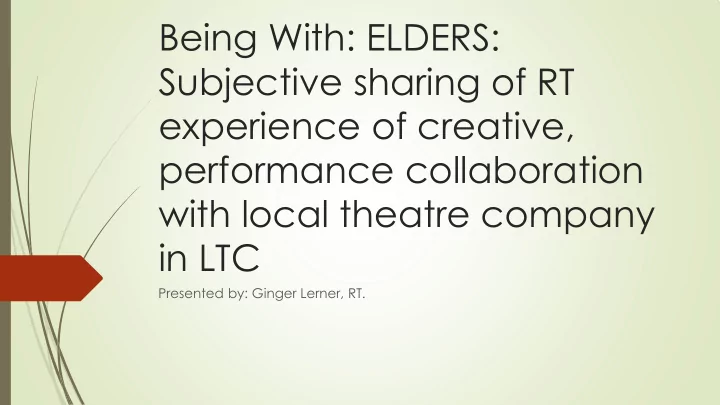

Being With: ELDERS: Subjective sharing of RT experience of creative, performance collaboration with local theatre company in LTC Presented by: Ginger Lerner, RT.
Overview of Project Collaborative Theatre. Long Term Care Environment/Home as ‘host’ Opportunities for validation.
This project relates to various NCTRC Job Analysis components including: Development of professional relationships of trust, assessment and adaptation for differing needs and desires within group, careful observation of participants to assess efficacy of program, well planned and delivered programs.
Learning Outcomes Upon Completion of this Session, participants will be able to: Identify at least 3 therapeutic goals associated with undertaking a collaborative performance project (highly personalized to resident participants, and professional performance participants). Identify 3 logistical considerations when undertaking a collaborative performance project. Identify how collaborative theatre can be part of resident, family and community centered care.
A note on visuals Challenge of consents!
Presenter Recreation Therapist. Have worked in LTC and Adult Day Centre's in Ontario and BC. Have worked at Louis Brier since 2014. No professional theatre background.
Question 1 for CTRA participants What is your practice setting?: Long Term Care Home Community Hospital Other
Question 2 for CTRA participants What population do you primarily work with: Seniors Adults Youth/ Adolescent Children Other
Question 3 for CTRA participants Have you participated in a theatre/performance based project within your practice setting? Yes No Brief description
Theatre Terrific
Theatre Terrific From their website: Theatre Terrific pioneers inclusive opportunities for artists of all abilities to develop performance skills and collaborate in the production of theatrical works. Through its work, Theatre Terrific challenges audiences to be open to the impact of thought provoking art. All of Theatre Terrific’s classes, workshops, community, and professional productions are made up of people of all colors, abilities, genders, and backgrounds. This means that at any given time, a cast or class may include people who may have mental health issues, developmental challenges, physical challenges, or simply practicing actors who want to learn new methods of inclusive theatre development.
How performance was devised Actor Recruitment Group workshops over 2 months Core group emerges Script is developed Professional photography Professional soundscape TR Concepts: Adaptive practice, strength based Flexibility from the start
Role of the Recreation Therapist Resident recruitment Booking space Assisting residents to come to the workshop Ongoing communication Presence throughout workshops Adjusting expectations
Role of the Recreation Therapist “The Big Day” Creation of the space. Ensuring families and staff know to assist with resident participation in timely fashion. RT toolkit! The project was challenging to account for using quantitative methodologies.
RT: Goals and Practice Did not submit ‘therapy minutes’. Did not devise distinct therapeutic Goals and Objectives. Documentation of attendance.
RT: Goals and Practice Holistic practice Resident & family centered care, examples: 1: Residents and families and community begin together with a relatively ‘blank slate’ - very equalizing for power relationships. 2: Residents and families devise pieces together, perform together on the stage. 3: Community members are invited to view the performance.
RT: Goals and Practice Professional Advancement and impact for Care Plans and program planning Resident capacities. Resident Personal Histories and meaning making. ‘Pausing’ inclinations to ‘correct’ interactions.
The Big Day(s)
Description of Performance – some highlights! Performance creation process had been very collaborative, frighteningly organic, but final show was very professional and consistent. 12 vignettes carefully placed to create a flow: Themes of youth, age, love, travel.
Vignette 1: Goals devised from theatrical process, and performance opportunity Poetry Goal: 1: Self-expression & reminiscence: Vocalization (possibly non-conventional) of life experience.
Vignette 2: Goals devised from theatrical process, and performance opportunity Ballet Goal: Physical: Participation in physical/demonstrative performance
Vignette 3: Goals devised from theatrical process, and performance opportunity Script reading Goal: Creative expression (assisting to devise performance piece)
Question 3 for CTRA participants: Call for suggestions Ways to incorporate theatre into TR practice settings?
Learning Outcomes: Completed! Upon Completion of this Session, participants will be able to: Identify at least 3 therapeutic goals associated with undertaking a collaborative performance project (highly personalized to resident participants, and professional performance participants – may include: 1: Emotional: Self-expression & reminiscence: Vocalization (possibly non conventional) of life experience. 2: Creative expression (assisting to devise performance piece) 3: Physical: Participation in physical/demonstrative performance Identify 3 logistical considerations when undertaking a collaborative performance project 1: Prospect of participant illness or facility outbreak 2: Communication management amongst general resident population, resident performers, families, professional community performers. 3: Security concerns of inviting public into Home (and of performers) Identify how collaborative theatre can be part of resident, family and community centered care: 1: Residents and families and community begin together with a relatively ‘blank slate’ - very equalizing for power relationships. 2: Residents and families devise pieces together, perform together on the stage. 3: Community members are invited to view the performance (with consideration for security).
Thank you!
Recommend
More recommend